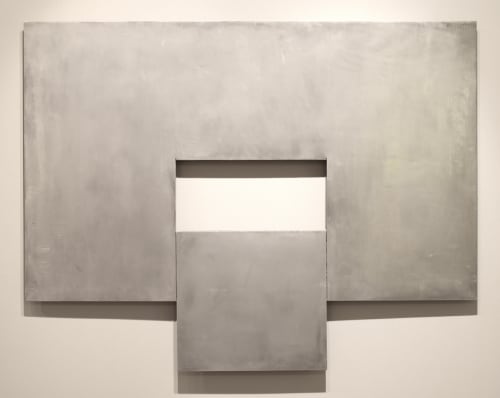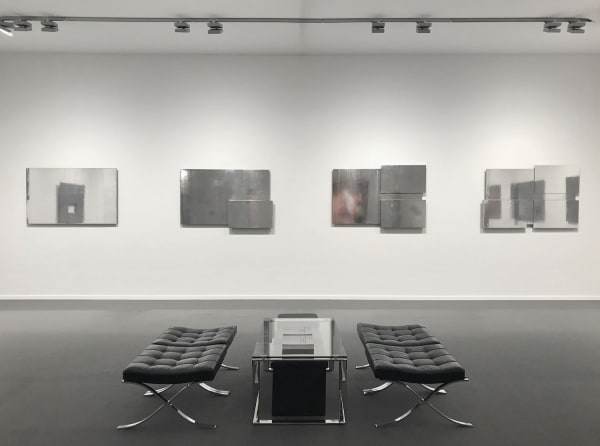Frieze Masters 2018
BorzoGallery and The Mayor Gallery proudly present a solo exhibition of Carel Visser at Frieze Masters 2018.
Carel Visser, Wall Pieces 1965-1968 | Text by Carel Blotkamp
Exactly 50 years ago Carel Visser represented the Netherlands at the 1968 Biennale in Venice, where his presentation was awarded the prize of the American David Bright Foundation. In the crystalline spaces of the architect Gerrit Rietveld's pavilion Visser showed a modest overview of his work, starting with some figurative sculptures from 1954 and concluding with a selection of recent geometric-abstract constructions. The exhibition was set against a striking backdrop from the hand of the Dutch interior designer Kho Liang Ie: the floor and a number of platforms in the room were covered in asphalt, like a road surface, which turned out to be the perfect foundation for Visser's sturdy iron sculptures. In contrast, the whitewashed walls of the pavilion provided a suitably airy backdrop for works of a completely different visual character: a series of wall pieces made of aluminium sheets. The bright Venetian light flooding through the glass roof reflected upon their surface with such intensity that they almost seemed to dissolve, like the polished bronzes of Brancusi so admired by Visser.
With Reg Butler and Lynn Chadwick in England, Eduardo Chillida in Spain and David Smith in the United States, among others, Carel Visser belongs to a generation of sculptors who, in the years after 1945, forcefully continued the tradition of crafting sculptures in iron, an art form created well before the Second World War by Picasso, Julio González and several Russian artists. Visser first encountered the work of González at the exhibition 13 sculptors from Paris at the Stedelijk Museum in Amsterdam in 1948/49, an experience which left a deep impression on the then 20-year old.
At the time, he had already learned to weld metal from workers at his father's construction company, where he occasionally created assemblages from leftover pieces of iron besides the massive objects he was carving from wood pilings. In short order these promising yet somewhat rudimentary experiments evolved into a serious sculptural ambition, alongside Visser's longstanding preoccupation with drawing. His vocational training - first as an architect at the Technical University in Delft, then as an arts teacher at the Royal Academy in The Hague - gave him little joy and in 1951 he exchanged academics for the life of an artist. Only a year later, four of his works were included in the prestigious international sculpture exhibition at Park Sonsbeek in Arnhem which had been organized in the wake of similar outdoor exhibitions at Battersea Park in London.
Visser's early work, like some of González's sculptures, consists of pieces of iron sheet, cut to size and pounded to a convex or concave shape, then welded together to create a plastic, modelled effect. He initially drew his inspiration mostly from nature, sculpting horses and birds, reed stalks and cactuses, but from 1954/55 his work, like that of many other artists, took a strong turn towards geometric abstraction during a period when the De Stijlmovement and pre-war constructivism experienced a revival. In this phase of his development, Visser also increasingly started to use iron in the raw, industrial state in which it is supplied from the foundry. He meticulously dismembered the solid plates, bars and beams and joined them in such a way that the parts remained readily identifiable, their order strictly governed by numerical sequences or by such principles as repetition, mirroring and rotation.
The concept of rotation features prominently in the many works collectively called Salamiby Visser, from the first half of the nineteen sixties. In each of these sculptures the pieces of a dissected iron beam are confronted by their original, intact shape. Some perform a precarious balancing act, such as the one in the collection of Tate Modern in London: the full weight of eight stacked cubes hangs from the horizontal beam, held together only by a thin weld. While their individual titles refer to physical objects (a sliced sausage, a train of freight cars) they are descriptive labels only, a case of free association and not indicative of a source of inspiration; these sculptures are effectively completely abstract. The central theme of Visser's work of this period is the destruction of the fixed, monolithic form, which is clearly linked (the artist himself indicated as much) to the erosion of institutional and individual authority which occurred during the nineteen sixties, brought on by a tidal wave of societal change.
Although they look very different, the wall pieces Visser began to make in 1965 and exhibited for the first time in November of that year, seamlessly connect to the iron Salamis. Each piece is an intact aluminium sheet about one centimeter in thickness. Sometimes another sheet is cut into four, six or eight rectangular strips which are then arranged at the edges of the first panel, either side-by-side or stacked on top of each other. At other times the unblemished sheet itself has been incised and the rectangular cut-out thus formed is pushed beyond the surface boundary, as if a monster tried to take a bite out of the piece.
To a large extent, works like these mirror the zeitgeist of the era in which they were created. In a general sense, Visser's iron sculptures represent the industrial age, even as their patina resembles that of ancient bronze. The aluminium wall pieces on the other hand fit with the shiny merchandise of the post-war period which spread across the world from the United States: the planes, the cars, the dream kitchens. This emergent consumer society is reflected most straightforwardly in pop art, but its aesthetics can be found everywhere in the art of the sixties, including in minimal art.
While it seems at first glance as if Visser's wall pieces were inspired by American minimal art, the movement had not yet registered with the European art scene in 1965, except through a few images in American magazines. Robert Morris had a solo exhibition in Düsseldorf in 1964 but the work of artists like Carl Andre, Dan Flavin and Donald Judd only came to the attention of the European public a few years later. Visser's work of that period is, therefore, an example of parallel evolution, related more closely to the minimalistic tendencies also already manifest in European art of the late fifties and sixties, in neo-constructivism, in concrete art and in the Zero movement. He was receptive to new developments in the arts throughout this time, and indeed in later years, when the character of his work again changed substantially. Yet he always maintained firm roots in the grand tradition of European modernist sculpture; of Arp, Brancusi, Giacometti, González, Picasso and Vantongerloo. This combination of qualities formed the fertile soil in which Visser's work flourished.
Carel Blotkamp, 2018
Translation: Jasper Blotkamp











